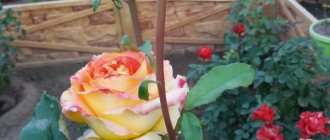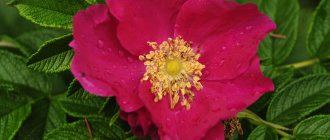Floribunda roses are very popular among gardeners. The reason for such love is the long flowering and relative unpretentiousness of this type of rose. We want to introduce you to the most important rules for caring for floribunda roses.
Roses don't like amateurs. If you are going to place a capricious beauty in a flowerbed, in the front garden, or to set up a rose garden on your property, you first need to learn the rules for caring for a rose. Everything is important here: how and when to plant it, how to prepare the soil, at what time to fertilize it, how often it needs to be watered and pruned, how to prepare it for winter. A mistake at any stage can result in the death of the plant.
We have prepared 9 rules for caring for floribunda to help the novice gardener.
The first floribunda roses were created at the beginning of the last century. These beauties turned out to have two “fathers”: some sources name the name of Peter Lambert, others – the Dane Poulsen. The plant appeared as a result of crossing polyanthus and hybrid tea roses. From the first, the floribunda inherited resistance to disease and frost, and from the second, a very beautiful bud of multiple shades. But the creator of the modern floribunda rose is considered to be the American breeder Eugene Berner.
Rule No. 1: choose high-quality planting material
How to choose the right rose seedlings? When choosing planting material, pay attention to the following points:
1. Rose seedlings can have an open or closed root system (sold in pots or in bags with a small amount of soil). Each of them has its own advantages:
- Seedlings with ZKS can be planted in the ground throughout the warm period of the year, until late autumn. In addition, they take root better and faster than bare-root roses.
- Seedlings with ACS have open roots, so it is clearly visible how developed the root system is, whether there are rotten or dry roots, etc., and they are cheaper than seedlings in pots.
2. Manufacturers often fill the stems of seedlings with wax. In this state, in a room with a low temperature, they can be stored for quite a long time. However, after the purchase, it may turn out that you were sold a cutting that will never wake up. To find out if roses are alive, carefully remove a piece of wax. If there is a green, healthy stem underneath, you can safely buy it. Some rose growers prefer to buy cuttings with green leaves that have already hatched: once the leaves appear, it means the seedling is alive.
3. Pay attention to the age of the planting material. The best option is two- and three-year-old seedlings with a well-developed root system and several (at least 2-3) stems.
It is best to buy rose seedlings from trusted nurseries. This way you will save yourself from disappointments, and your family budget from useless expenses.
4. Don't make rash purchases. When going for rose seedlings, study the information and make up a clear “portrait” of the rose you want to purchase: the height of the bush, the size and shape of the flowers, flowering time, disease resistance, etc. This will save you from buying, for example, a 3-meter beauty that there is simply nowhere to place it on your site.
What is floribunda
History of the origin of the variety
It is still not clear which of the two breeders - the Dane Svend Poulsen or the German Peter Lambert - is the author of the floribunda, but this hybrid appeared as a result of crossing hybrid tea and polyanthus roses. And the creator of more than sixty modern highly decorative varieties of floribunda, which are grown today all over the world, is the American scientist Eugene Berner.
Botanical description
From polyanthus roses, floribunda inherited a richness of colors and bud shape, and from hybrid tea roses - resistance to low temperatures, various diseases and pests. The diameter of flowers of this class reaches 4-8 cm. Simple, double, semi-double and densely double flowers can have a goblet or cup shape.
Floribunda bushes are characterized by a bouquet type of flowering, when many flowers form a large inflorescence. These roses bloom for a long time, abundantly, but in waves: the period of mass formation of flowers is replaced by a period of less intense flowering.
- Lotus settled in the country house
Plants of this class are striking in their variety of colors. A relative disadvantage of some varieties of floribunda is the lack of scent in the flowers. According to the height of the bush, varieties are divided into border varieties (up to 40 cm in height), medium-growing (from 60 to 80 cm) and tall-growing (from 1 m and above). Floribundas are planted along borders, as a tapeworm on lawns or in group compositions with ground cover and perennial herbaceous crops.
In the photo: Pink rose Floribunda
Rule #2: Plant at the right time of year
In the middle zone, the ideal time for planting roses with an open root system is May-June, when the earth has already warmed up well.
Residents of the southern regions of Russia can plant roses in the fall (mid-September - mid-October) - the plants will have time to take root before the onset of frost. In the northern regions and the middle zone, autumn planting of roses rarely ends successfully. And all because frosts can strike suddenly and the rose will go to winter without taking root. Most likely, such a plant will die from the cold.
Roses with ZKS, as mentioned above, can be planted throughout the entire growing season.
How and where to buy Cosmos rose seedlings
Many well-known nurseries and breeders sell rose seedlings. The high quality and unpretentiousness of the plant make it desirable for many who like to decorate the garden with rose bushes.
- When purchasing, it is worth clarifying the specifics of plant delivery. If you use postal services or a transport company, make sure that the seedling will be securely packaged. This means that the bush is placed in a rigid frame, which will prevent damage to the seedling. The walls will reliably protect from the harmful effects of external factors and stem deformation.
- Be sure to study reviews about the company and communicate on large forums with people who have previously purchased varietal roses. In such conditions, you can find out some of the nuances of ordering seedlings via the Internet or by phone.
And yet, having bought a high-quality plant and planted it on your plot, very soon you will be able to convince yourself of the beauty of this variety. She fully lives up to her name, as she looks incredibly attractive and bewitching.
Rule #3: Use a well-lit area for planting.
Floribunda roses love light, so for planting it is important to choose a well-lit place (south, southeast or southwest side of the site), protected from drafts. To prevent the buds from burning out and drying out prematurely, be sure to shade the bushes in the midday heat.
When planted in a shady place, roses may stop blooming altogether, and black spots will appear on the leaves. And powdery mildew, which also appears in a shady and damp place, can greatly spoil the life of both you and the plant. Roses also do not like close proximity to groundwater.
Roses have no special preferences regarding soil - the main thing is that it is breathable and loose. If you have clay soil, add sand or peat to it, and if sandy, add organic matter.
Floribunda rose in landscape design
In country houses and garden plots, floribunda is often used as hedges. Varieties of roses with a strong aroma are recommended to be placed near houses and gazebos. Low-growing shrubs look great as a frame for garden paths and alpine slides. Tall roses, together with other flowers, are placed in the background.
A single floribunda placed in a lush lawn looks incredibly gorgeous and can alone create a striking accent. Such a solo rose will mean more than a whole rose garden of simpler types of roses.
Floribunda in the garden will always attract attention
Floribunda is a general name for a number of magnificent roses with excellent decorative characteristics, unpretentiousness and resistance to diseases. This is an excellent solution in landscape design, because even one rose can decorate the most modest garden.
Rule #5: Plant roses according to the rules
The planting process is the most responsible, but at the same time it is not at all complicated. So, you have prepared the planting hole. What to do next?
- Sprinkle it with plenty of water.
- Place a layer of drainage at the bottom of the hole: expanded clay, small pebbles, etc.
- Pour half a bucket of the prepared fertile mixture into the hole, forming a small mound.
- Place the seedling in the center of the mound.
- Gently distribute the exposed roots over the free area.
- Cover the roots with fertile soil, carefully compacting it so that there are no voids near the roots. After planting, the root collar should be 3-5 cm below the soil surface. When planting roses with ZKS, make a depression in the planting hole and lower the rose into it along with a lump of earth (pre-moisten the soil in the pot well so that it does not crumble).
- Water the plants generously around the edges (not at the roots!).
- After the water is absorbed, be sure to mulch the tree trunk circle with peat, straw or expanded clay.
Plant floribunda rose bushes 50cm apart.
Popular varieties and their descriptions
The varietal diversity of floribundas is great. But there are a number of roses that are most popular among gardeners, their names and brief characteristics:
- Stromboli - the height of the bush is about 80 cm. The leaves are shiny, deep green. The flowers are cup-shaped, double. The inflorescence has from 3 to 10 buds, the petals are grooved. The aroma is weak, flowering is abundant and long lasting.
- Lilly Marlene - 70 cm, green leaves with a bronze tint. The flowers are slightly double, the color is bright red. The smell is strong.
- Bluevender is a spreading shrub about 60 cm. The leaf blades are dark green with a glossy surface. The flowers are medium-sized, double, pink with an orange tint.
- Blue for you - the rose is unique in its color, blue and lilac. The shape of the flowers is also unusual; even when open, they resemble buds that are not fully ripe. Reaches from 80 to 90 cm, blooms until mid-October.
- Galaxy is an 80-centimeter beauty with two-color petals, yellowish and light burgundy. The peculiarity of rose is its aroma, which is similar to the smell of linseed oil.
- Raffles Dream is one of the most unusual and popular roses. It stands out strikingly with its large and lush buds. Its petals are attractive - they are corrugated, cut along the edges. The color of a rose can be very different. But such beauty is not without its drawback - the rose is prone to fungal diseases, which requires careful and regular prevention.
Rose Sympathie - variety description
The updated edition of the rose catalog includes a separate species of floribunda - Spray rose. These are plants not exceeding 50 cm, studded with many small buds with a diameter of 4 to 7 cm.
Additional Information! Frisia has the longest flowering period with yellow flowers that do not fade in the sun. Flowering lasts until frost.
Blue for you - a rose for those who want to effectively highlight their garden
Rule #6: Pruning on time
Pruning floribunda roses stimulates abundant flowering and the growth of basal shoots. Some shoots are pruned heavily, while others have only a small part of the stem removed.
Pruning of adult floribunda rose bushes is carried out 3 times a year:
- Spring pruning: after planting, in subsequent years - before the start of sap flow (in the first half of April). Shorten all one-year-old shoots of bushes by a third, and leave 3-5 buds on two-year-old ones. Also, during spring pruning, you can completely remove old shoots that thicken the bush.
- Summer pruning: its purpose is to stimulate flowering. Remove all faded inflorescences from the plant.
- Autumn pruning: remove old, undeveloped branches and leaves for successful wintering of the rose.
Growing a flower, how to plant it correctly in open ground
Rose Osiana (Osiana) - description of a hybrid variety
Planting and the first 30 days of care play a decisive role in the future existence of the rose bush. This point should be given maximum attention.
In what form is planting carried out?
Hybrid varieties are most often sold as grafted seedlings. Planting material must be healthy in appearance, without mechanical or painful damage. It is better to buy seedlings bred in the same region where they will be planted.
What time does boarding take place?
Young bushes can be planted from March to October. The optimal period for planting is spring.
Selecting a location
The rose tolerates partial shade for several hours throughout the day. The hybrid is afraid of through cold winds and groundwater. This should be taken into account first when choosing a place to grow.
How to prepare the soil and flower for planting
The soil should be loose and nutritious. A good combination would be a mixture of:
- humus;
- clay;
- river sand;
- peat
For nutrition, add bone meal and superphosphate. You can increase the survival rate of a young bush by treating its roots with a clay mash 30 minutes before planting.
Step by step landing procedure
When the soil and seedling are ready, you can start planting it:
- The planting hole is dug to suit the size of the seedling's root system. The depth should be twice as long as the roots.
- The bottom of the hole is filled with 10 cm of drainage.
- A layer of compost is laid on top of the drainage layer.
- The prepared soil mixture is poured into a heap.
- The seedling is installed so that the grafting site is deepened by 5-7 cm.
- The top is filled with soil mixture.
Deepening the seedling for proper growth
Next, the rose is watered abundantly and mulched with sawdust or peat. After planting for 2 years, the young bush feeds entirely from the planting hole. There is no need to do additional fertilizing.
Rule #7: Don't overwater
Roses love water. Water them once a week. In hot weather, do this twice as often. One adult bush will need a bucket of water.
Water your roses in the early morning or evening. Pour water not to the roots, but into a small ditch dug at a distance of 10-15 cm from the stem. When watering in the evening, try not to get water on the leaves of the plant - this can lead to fungal diseases. Sprinkling the rose can only be done in the morning so that the moisture has time to dry out during the day.
During the period of rapid development (when buds and leaves appear), as well as after the first flowering, watering is especially important. At the beginning of autumn it must be stopped, otherwise the rose will continue to grow and will not have time to prepare for winter.
But at the end of October, on the eve of a cold snap, carry out moisture-charging watering: the plant should saturate the roots and stems with moisture to make it easier to withstand winter frosts.
Floribunda roses: description, photo, names, planting, care
Rose is a beautiful flower that will decorate any flower bed. Today there are a huge number of species of this plant, and the Floribunda variety is one of the most common. This is not surprising, because it has decent external qualities and is highly resistant to external factors.
The name “Floribunda” itself translates as “abundantly blooming”. The variety was developed through long efforts of breeders. The work began back in the 20s of the last century. The Floribunda variety was officially registered in 1952. Selection work continues to this day; a large number of roses are now known, which differ in the height of the bush, the number of buds, and their shade.
Description of the variety
The Floribunda variety means that the bushes exhibit lush and abundant flowering. There are a huge number of subtypes of the variety that differ in appearance.
No other group has so many varieties.
Flowers can be simple, semi-double, or double, can have a goblet or flat cup, and can be collected in small or large inflorescences. The flower size is usually from 4 to 9 cm.
Most Floribunda roses bloom in three stages. The flowers gradually open several at a time. There are also varieties that bloom continuously.
There are several advantages that distinguish Floribunda roses from the rest. This should include:
- resistance to low temperatures;
- resistance to typical flower diseases;
- ease of care;
- possibility of propagation by cuttings.
Floribunda roses are actively used for outdoor landscaping. They look great in parks or in flower beds near large, frequently visited buildings. Some varieties are used as cut varieties.
The best Floribunda roses
It has already been said above that a huge number of varieties of Floribunda type roses have been bred. They differ in color scheme and other parameters. Below are the names of the best varieties that are currently being actively planted.
White varieties
Many people like white varieties of Floribunda roses. This color is not found very often, which is why it is admired.
For example, a variety of roses called Alabaster are small bushes on which you can observe 10-centimeter buds all season long.
They are not very resistant to rain, but they are excellent at resisting disease. But white Cosmos roses are ideal for rainy regions.
The Iceberg variety has a strong aroma. These roses bloom from July to September. They do not tolerate cold very well and require shelter during the winter.
Rose Floribunda Snowflake is one of the most attractive options. The flowers resemble the shape of snowflakes, in honor of which this variety was named. These roses have almost no scent at all.
Yellow varieties
Among Floribunda roses, yellow flowers are quite common. Rose Raffles Dream Floribunda is not quite a yellow shade, rather it is more of an orange or apricot shade.
Pinkish petals are often found, making roses even more unusual and attractive. This variety generally has an original appearance, as it resembles lace. Any soil is suitable for planting.
You can also plant Raffles Dream on balconies.
Rose Rumba can be classified as a yellow variety, but as it blooms, pink petals appear in the buds. By the end of the period, the edges of the petals become crimson. The reverse side and center of the bud always remains yellow.
A small drawback of Rumba is that the fading buds do not fall off, but remain dried on the bush. This spoils the appearance and reduces the value of the rose as a flower bed plant.
However, the problem is easily solved by timely pruning of dried flowers.
The yellow rose Arthur Bell has beautiful flowers, but they fade quickly, which is a drawback of the variety. Quite quickly the buds become creamy and lemony. This is why roses are not planted in sunny regions.
The Freesia variety, distinguished by its golden buds, is one of the most popular. Flowering begins in June and lasts until the first frost.
The Geisha rose has apricot flowers and is loved by gardeners for its long, abundant flowering. The shade of the buds is close to apricot-orange.
Yellow Golden Border roses bloom continuously from spring to fall. They do not require special conditions and bloom well even in sunny areas. The flowers do not fade and retain an attractive shade.
Samba is a variety that begins to bloom with yellow buds, but their shade changes over time. Flowers do not fade or become lighter. On the contrary, as they bloom they become brighter and pink petals appear.
Golden Dreams are lush yellow flowers with a delicate scent. They are well suited for both growing in flower beds and for cutting.
Pink varieties
Pink Floribunda is one of the most common options. Among the best varieties is Pomponella. It has a long flowering period, lasting from late spring to early autumn.
During this period, new buds constantly appear on the bush, so flowering is considered continuous. Pomponella roses do not fade for a long time and retain their shape perfectly.
They also perfectly withstand the impact of rain and do not suffer from it.
Another pretty pink variety is Leonardo da Vinci. It is distinguished by the spherical shape of the flowers and a rich pink hue. These characteristics make the bushes a real decoration of the garden or park. The flowers also have a light fruity aroma. The rose received its name in honor of a famous person.
Midsummer is also a pink variety of Floribunda. The name of the variety translates as “midsummer”, and it is at this time that roses begin to bloom. A distinctive feature is the presence of a yellow tint in the color, which makes the flowers unusual and bright. Midsummer has virtually no aroma.
The pink rose Prince of Monaco blooms throughout the summer, and the shade range of flowers is constantly changing. Towards the end of the period it becomes a rich crimson.
The name of the Queen of Hetz rose translates as “queen of hearts”, and she looks really royal. It has impressively bright salmon-colored flowers that are visible from afar. The variety is characterized by long flowering, observed throughout the summer months.
The variety called Brothers Grimm is distinguished by its attractive colors, which combine several shades of pink. The variety can be grown on different types of soil; the rose is not too demanding.
The Baroness type of roses is invariably chosen by flower growers who are attracted by bright shades. Flowers are not subject to fading under the influence of sunlight and remain unchanged on the bush for a very long time.
The attractive pink rose Queen Elizabeth Floribunda was named after the Queen of Great Britain. The flowers are very resistant to rain and are not damaged even by heavy downpours.
Marie Curie are quite pretty pink flowers that during the flowering period change shade from darker to lighter. Rose has a light spicy aroma.
Types of red
Rose Nina Weibul has bright red inflorescences. It is one of the most popular varieties with buds of this color. This variety is particularly frost-resistant, so it is actively used even in the coldest regions. The rose blooms until the first frost.
The Niccolo Paganini variety has velvety red flowers. It is loved by many gardeners for its rich shade and abundant flowering. A distinctive feature is increased resistance to heat and drought.
Unusual varieties
Among the roses of the Floribunda category, there are also unusual options. For example, the Blue Fo You variety has blue buds. Depending on external conditions, the color may change, becoming lilac or violet, but this does not change the originality of the rose.
Another non-standard variety is Ebb Tide. It has an unusual shape of flowers, which are colored in a rich plum shade. Roses have a strong aroma, reminiscent of cloves.
Love Song is a unique rose with a lavender hue. A distinctive feature is that the variety does not change its color. It doesn’t matter where the roses are planted - in the sun or in the shade, they will still retain their unusual appearance.
Heidi Klum's variety will also appeal to lovers of unusual roses. It has lilac flowers, but the shade may vary depending on the soil used and other factors. The varieties have one thing in common - as they bloom, the buds always become brighter.
The list of unusual colors is completed by the Lovely Green variety. It has a rather non-standard color – white with a light green tint. The shape of the flowers resembles a ball.
Planting Floribunda roses
Before planting roses, you need to select suitable areas for them. Floribunda varieties appreciate the sun, but constant rays are not suitable for them; this often leads to fading and rapid flowering. It is advisable to plant flowers in the spring, but planting in the fall is also possible. The most suitable periods are April-May and September-October.
The soil needs to be prepared in advance. The area should be dug up to the depth of a shovel, and then fertilizer should be applied there. A mound is formed in the planting hole, onto which the shoot then descends.
The roots should be shortened to 25 cm. They should be evenly distributed over the mound, doing this as carefully as possible so as not to damage. Next, the hole is filled with soil, which should be compacted and watered.
At first, the seedlings should be protected from the sun.
Rose care
Proper care and cultivation include:
- watering;
- loosening the soil cover;
- mulching;
- fertilizer;
- shelter for the winter.
Roses should be watered regularly, this is especially important at the beginning of their growth. Thanks to a sufficient amount of water, new shoots, leaves, and buds will form well for the further development of buds. The bushes should be watered at least once a week. It's best to do this in the evening. For irrigation, warm water is taken after settling.
https://www.youtube.com/watch?v=HhrQ7ugY4cE
Loosening should be carried out to a depth of no more than 10 cm. Otherwise, there is a risk of damaging the delicate roots. Mulching refers to the use of organic material that will prevent weed growth and retain moisture in the soil.
Roses must be fed. If a sufficient amount of fertilizer was applied during planting, then in the first year you do not need to fertilize.
Then it should be carried out every year, and fertilizers should be added 5-7 times per season. Preparation for winter includes spreading potash fertilizers in dry form. This should be done in early November. Also, caring for a Floribunda rose in the fall includes pruning and covering for the winter.
Pruning Floribunda roses
Pruning is very important for roses, as without it the bushes will grow greatly and the stems will remain weak. Typically, shoots are pruned twice per season.
Proper pruning in spring is done after the weather is finally warm. It is imperative to eliminate outdated branches that are more than 2 years old, as well as those that are damaged or no longer alive or dried out.
You should also remove the top area of the bush and make the side shoots shorter.
Pruning Floribunda roses in the fall is necessary for newly acquired bushes that are just planning to be planted. It is necessary to shorten the shoot and remove old, damaged roots as much as possible. In the future, autumn pruning for the winter should include the removal of unnecessary shoots that do not have flowers.
by trimming:
How to cover floribunda roses for the winter
Sheltering Floribunda roses for the winter is a mandatory action, without which the plant may die during frost. After sanitary pruning and shortening of the shoots, it is necessary to hill up the bush. Next, you should cover the roses with spruce branches or use non-woven material for this purpose.
Rule No. 8: Feed your roses in a timely manner
It is very important to fertilize roses correctly throughout the year. You need to start fertilizing from the second year of the plant’s life.
- After pruning, before the leaves bloom, and two weeks after that, feed the roses with ammonium nitrate (30 g per 1 sq.m.) or organic matter: mullein diluted with water (1:10).
- During the period of bud formation, roses will benefit from a complex mineral fertilizer for flowering plants, such as Agricola or Fertika.
- Before the first flowering, feed the roses with mineral fertilizer: dissolve 1 tbsp in a bucket of water. potassium sulfate, the same amount of Agricola rose fertilizer and 2 tbsp. nitrophoska.
- After the first flowering, feed the roses with complex mineral fertilizer (see the dosage on the label). Remember that from August you should not feed plants with nitrogen fertilizers.
- In autumn, fertilizing with potassium salt and superphosphate (30-40 g per 1 sq.m.) is acceptable. Fertilizers during this period should not contain chlorine.
Flower propagation
The easiest way to propagate Sim Salabim is by cuttings. There are also more complex and labor-intensive methods - propagation by grafting or seeds.
When is it produced?
You can cut a rose from the beginning of June until the end of July. Grafting of cuttings is also carried out during this period. Seeds should be planted after collecting them.
Detailed description
There should be two cuts on the cutting. The lower one is oblique, the upper one is straight. There should be three buds on the cutting. Reproduction of roses by cuttings step by step:
- The lower leaves are removed completely, the upper ones halfway.
- The cuttings are planted at an angle.
- The nursery is covered with film or glass.
The cuttings require regular watering, loosening and feeding. For the winter, the nursery is well insulated.
Rule #9: Cover your roses for the winter
Roses should be covered for the winter. Start preparing bushes for winter hibernation in mid-October. Before the shelter, autumn sanitary pruning is carried out, during which it is necessary to remove leaves, unripe buds and shoots - all this is burned.
Then, for preventive purposes, treat the roses with 1% Bordeaux mixture or 3% iron sulfate. Remember that treatment with iron sulfate can be carried out only after there are no leaves on the rose in order to burn the leaf blades.
Give preference to air-dry covering of roses. Before you cover the plant, do not forget to insulate the roots: pour a layer of peat or soil (20-30 cm) under the bush.
A little care and attention - and the floribunda will definitely bloom long and profusely, delighting you with its unique beauty.
Diseases, pests and ways to combat them
Salabim, like other varieties of roses, is subject to attacks by pests and some diseases.
Powdery mildew
Most often, the plant dies from root rot or powdery mildew. This occurs when there is excess moisture. Either the location was chosen incorrectly - close to groundwater or excessive watering.
Among the pests, the most dangerous enemy is the spider mite. It cannot be confused with anything; the leaves and stems are covered with a web. These small pests draw out all the juices from the bush. A plant deprived of nutrition withers and dries out.
Chemistry will help in the fight against them. The following drugs have proven themselves to be effective:
- actellik;
- bankol;
- confidor;
- karbofos.
The treatment will have to be repeated at least 4 times per season. The break between treatments is 3 days. Work should be carried out in dry, windless weather in the morning or evening.
Important! We must not forget about protective equipment.
The Sim Salabim variety is so unusual that the question arises: “Is this a rose?” The lemon-yellow petals of the bud are mottled with dark burgundy stripes, stains, and splashes. They are always different. Although the variety is not often found in Russian gardens, it can take the main place in any plot.
Soil for floribunda
Planting and caring for this type of roses requires the correct selection of soil. Floribunda “loves” sandy-clayey soil, quite loose, abundantly saturated with oxygen. To do this, you need to add a small amount of humus to the soil.
The area where the floribunda will “settle” should be thoroughly cleaned of debris and dry leaves and dug well. The hole must be at least 50 cm deep and the same cm in diameter. It is recommended to add a couple of parts of garden soil, some sand, humus and peat. And some more crushed clay.










